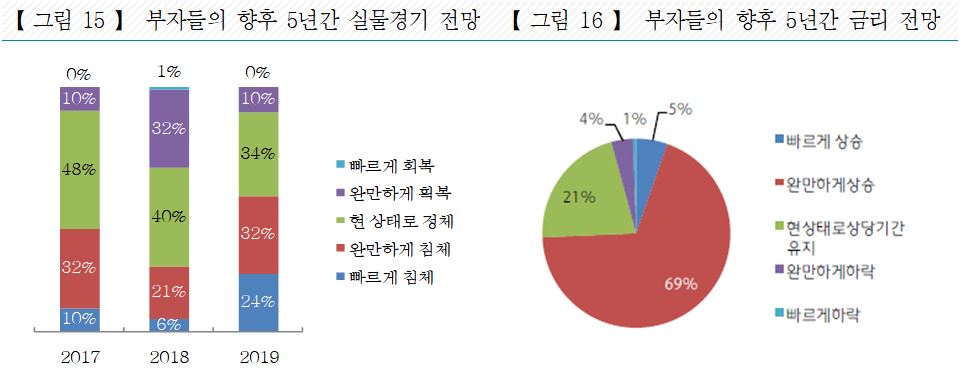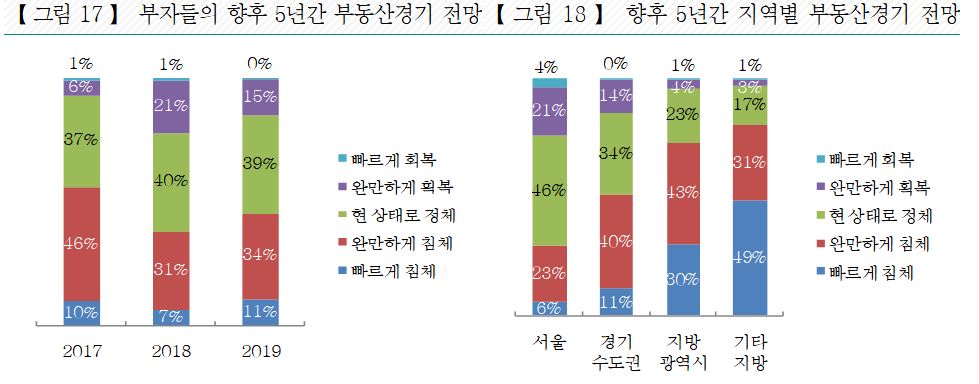
금융자산 10억원 이상을 보유한 부자들은 올해 부동산 경기에 대해 부정적인 전망을 하고 있는 것으로 나타났다. 하지만 서울지역에 보유한 부동산 자산은 현 상태로 유지할 것이라는 의견이 높았다. 부자들 절반 이상이 상속·증여를 받은 경험이 있고, 자산형성 기여도는 부동산 투자가 가장 높은 것으로 나타났다. 또한 보유자산의 48%는 노후자금으로, 43%는 자녀에게 물려줄 계획인 것으로 조사됐다.
최근 KEB하나은행(은행장 함영주)과 하나금융경영연구소(소장 정중호)는 이같은 내용을 담은 우리나라 부자들의 자산관리 형태를 분석한 발간한 '2019 Korean Wealth Report'을 발간했다. 이번 보고서는 금융자산 10억원 이상을 보유한 KEB하나은행 PB손님 중 총 922명의 설문 내역을 분석한 결과이며, 특히 부자들이 보유하고 있는 부동산의 종류 및 지역, 투자행태 변화, 자산축적 및 노후준비 계획 등에 대한 조사를 포함한 점이 중요한 특징이다.
#향후 경기전망에 대해 부정적인 응답이 다수
부자들은 부정적인 경기전망을 하고 있는 것으로 나타났다. 향후 5년간 국내 실물경기 전망에 대해 3분의 1 정도가 현 상태로 정체되고 단지 10% 정도만 완만하게 회복되는 것으로 보는 반면 절반 이상이 침체될 것으로 전망하고 있다. 신정부 출범에 따른 기대감과 기업실적 호조로 직전 조사에서 보였던 낙관적인 경기전망이 비관적인 경기전망으로 선회한 것이다. 한편 금리변화에 대한 인식은 90% 정도가 상승할 것으로 보고 있어 부자들은 금리상승이 임박해 있음을 실감하고 있는 것으로 조사됐다.

#2019년 부동산 전망은 부정적, 자산 구성은 현 수준을 유지
국내외 경기 둔화가 가시화되는 가운데 정부의 고강도 부동산 정책으로 조정 국면이 예상되는 상황에서 부자들은 실물 경기와 부동산 경기에 대해 어떤 전망을 하고 있을까? 향후 5년간 국내 실물 경기(부동산 경기 포함)에 대해 부자들의 절반 이상이 침체될 것으로 보고 있어 지난해 조사에서 보였던 낙관적인 전망이 비관적으로 선회했다. 다만 부동산 경기는 지역에 따라 차이를 보였는데 서울지역의 경우 현 상태로 유지된다는 답변이 46%로 가장 컸지만 지방 부동산에 대해서는 응답자의 82%가 침체될 것으로 전망하였다. 서울과 지방의 온도차이가 크다는 것을 보여준다.
다만 실물 경기와 부동산 경기를 부정적으로 보는 상황에서 부자들의 46%는 현재 자산 구성을 유지할 것이라고 밝혀 적극적인 자산 리밸런싱보다는 관망하는 경향이 우세한 것으로 나타났다. 자산구성을 변경할 것이라고 밝힌 응답자 중에서 부동산 비중을 축소하고 금융자산 비중을 확대할 계획인 응답자 비중은 18%이고, 부동산 비중을 확대하고 금융자산 비중을 축소하겠다는 응답자 비중은 13%로 나타났다.
하나금융경영연구소 안성학 연구위원은 “지난해 결과와 비교할 때, 현재 자산구성을 유지하겠다는 비중이 증가하였는데, 이는 대내외 금융시장의 불확실성이 커지면서 자산 변경에 더 신중한 태도를 보였다.”고 설명했다.

#부동산 자산에 대한 선호가 유지되는 가운데 고령층의 상업용부동산 보유 비중 높아
현재 부자들의 자산 포트폴리오 중 부동산 비중이 53.1%로 전년대비 소폭 증가한 것으로 나타났다. 지역별로 보면 서울 및 수도권 거주자의 부동산 비중이 증가한 반면, 지방 거주 응답자는 감소한 것으로 나타나 지역별 부동산 양극화 현상이 일부 반영되었다.
보유 부동산 유형별로 보면 상업용부동산이 가장 큰 비중을 차지하고 거주목적주택, 투자목적주택, 토지 순으로 나타났다. 다만 상업용부동산 비중이 전년대비 감소하였고 거주목적주택과 투자목적주택의 비중이 소폭 증가하였다. 연령대별로 보면 60대와 70대 이상 고연령층에서 투자목적주택 비중이 낮고 상업용부동산 비중이 높게 나타났다. 연구소에서는 고연령층의 경우 노후생활을 영위하기 위한 수단으로 투자목적주택을 통한 자본이득보다는 상업용부동산을 통한 안정적인 소득을 더 원하기 때문으로 보았다.
거주목적이 아닌 투자목적주택을 한 채 이상 보유한 응답자 비중은 93%로 상당히 높고 가장 선호하는 투자목적주택 유형은 중소형아파트로 나타났다. 상업용부동산을 한 채 이상 보유한 응답자 비중도 92%로 나타나는 등 거주목적 외의 부동산 자산을 상당부분 보유하고 있는 것으로 조사되었다.
한편, 다주택 보유자 중 임대사업자로 등록한 응답자 비중은 37%로 대부분 2017년 8.2대책 이전에 임대사업자로 등록하였을 뿐만 아니라 향후 임대사업자 등록을 하겠다는 비중은 11%에 불과하였다. 이에 연구소는 2017년 12월 발표된 정부의 임대주택활성화 정책이 부자들의 임대사업자 등록에 미치는 영향은 크지 않은 것으로 보았다.

#중위험·중수익 상품에 대한 선호가 지속되면서 PB에 대한 의존도 높아져
지난해 하반기 주가가 연초대비 큰 폭으로 하락해 전반적으로 자산수익률이 저조한 가운데 부자들의 평균 금융자산 수익률도 1.86%에 불과해 지난해 대비 4.75%p나 하락한 것으로 나타났다. 이러한 시장 환경에서 부자들은 2019년에 어떤 금융상품 투자를 선호했을까? 1순위는 단연 지수연계 금융상품(ELS, ELT)이 차지하였으며 다음으로 단기금융상품, 정기예금 등의 순이었다. 금융시장의 불확실성에 대비하여 적정 수준의 유동성을 확보하면서도 안정적인 자금을 운용하려는 수요가 확인되었다. 한 가지 특징적인 것은 사모펀드에 대한 선호도가 주식 직접투자나 주식형 펀드보다 높게 나타났는데 이는 부자들이 사모펀드와 부동산대체투자펀드 등 대체투자자산에 대한 관심이 크게 증가하였음을 시사한다.
이러한 환경 변화에 따라 부자들은 자산관리 및 운용에 대한 의사결정 시 의논하는 대상으로 PB(65.4%)를 가장 선호하는 것으로 나타났다. 이는 지난해에 비해 15.7%p나 증가한 수치이다. 안성학 연구위원은 “자산수익률이 낮아지면서 중위험·중수익 상품, 사모펀드 등에 대한 부자들의 관심이 높아지고 향후 투자의사 결정에 있어 PB의 역할이 한층 더 커질 것”으로 보았다.
#부자들의 소비성향은 30%로 낮고 70대 이상 고연령층의 지출이 가장 큰 편
부자들의 2018년 소비행태를 보면 가구당 월평균 지출은 1,226만원으로 일반가계(332만원) 대비 3.7배 높은 것으로 나타났다. 소비성향(소득 대비 소비 비율)을 보면 부자의 소비성향이 약 30%인 반면 일반가계는 약 70%로 나타나 부자들의 저축이나 투자 등을 위한 여유자금이 충분히 많은 것으로 나타났다.
지역별로 강남3구 거주자의 지출액 및 증가율이 가장 높게 나타난 반면 지방 거주자의 경우 지출규모는 수도권 부자보다 많지만 지출 증가율이 0.5%에 불과하였다. 연령별로 보면 지난해 지출규모가 가장 컸던 60대를 제치고 70대 연령층의 지출규모가 가장 높게 나타났다. 연구소는 빠른 고령화와 함께 액티브 시니어들의 증가로 고령층의 문화생활 및 사회활동 폭이 더욱 넓어졌기 때문으로 설명하였다.
향후 지출 항목별 계획을 보면 ‘문화 및 레저’와 ‘의료비 및 의약품비’를 가장 많이 늘리고 ‘의류 및 잡화’와 ‘외식비’를 감축할 것으로 응답하였다. 지난해와 유사한 결과를 보였으나 외식비를 줄이겠다는 응답 비중이 크게 증가하였다. 삶의 질 개선을 위한 문화생활과 건강 문제에 대해 부자들의 관심이 크다는 것을 보여준다.

#부자들 절반 이상이 상속·증여를 받은 경험이 있고, 자산형성 기여도는 부동산 투자가 가장 높아
상속 또는 증여 받은 자산이 있다고 응답한 비중은 57%로 나타났으며, 특히 보유자산 규모가 클수록 자산이전을 받은 경험이 있다는 응답 비중도 높았다. 부자들의 자산형성에 있어 상속 또는 증여와 같은 세대간 자산 이전이 어느 정도 영향을 미친 것으로 나타났다.
현재 보유자산에 대한 기여도를 보면 부동산 투자가 27%로 가장 높고, 사업소득 20%, 근로소득 19%, 금융자산투자 19%, 부모의 증여·상속 15% 순으로 나타났다. 자산형성에 있어 부동산 투자가 가장 중요한 수단이나 사업소득, 근로소득, 금융자산투자도 자산축적에 상당히 기여하고 있음을 알 수 있다.
#보유자산의 48%는 노후자금으로, 43%는 자녀에게 물려줄 계획
향후 부자들은 보유자산을 노후자금으로 48%, 상속 24%, 증여 19% 등으로 활용할 계획이며, 기부하겠다는 응답도 4%로 나타났다. 응답한 부자들 중에서 재산의 일부를 이미 자녀 또는 손자에게 증여했다는 답변은 53%에 이르고 증여자산 형태는 현금·예금이 52%로 가장 높고 상업용부동산 20%, 주거용부동산 17% 순으로 나타났다.
향후 계획하고 있는 상속·증여 자산 유형을 보면 부동산이 44%로 가장 높은 선호도를 보였으며 지난해와 비슷한 수준을 보였다. 다음으로 현금·예금(31%), 주식·채권·펀드(9%) 등 금융상품을 활용하는 순으로 나타났다. 특히 부동산의 경우 2016년 39.7%, 2017년 44.1%, 2018년 44.2%로 매년 증가하는 반면 금융자산을 활용하려는 비중은 낮아지는 추세를 보였다.
하나금융경영연구소 이경진 수석연구원은 “부동산 경기가 안 좋은 상황임에도 불구하고 금융상품보다 안정적인 임대수익이 가능하고 미래가치의 상승이 기대되는 부동산을 상속·증여 수단으로 활용하려는 경향이 점차 뚜렷해지고 있다.”고 진단했다.

[Analysis] Rich people, the economic outlook for the next five years is 'negative'..." "Seoul Real Estate is protected."
Rich people with more than 1 billion won in financial assets have a negative outlook for the real estate market this year, a report showed Sunday. However, many said that real estate assets held in the Seoul area will remain the current state. More than half of the rich have received inheritance and gift, and their contribution to asset formation is the highest. The survey also found that 48 percent of their assets will be transferred to their children for retirement and 43 percent will be transferred to their
Recently, KEB Hana Bank (KEB Hana Bank president Ham Young-joo) and Hana Financial Management Research Institute (chief Jung Kyung-ho) published the "2019 Korean Wealth Report," which analyzed the asset management patterns of Korea's rich people. The report is based on an analysis of a total of 922 PB customers of KEB Hana Bank, who have more than 1 billion won in financial assets, and is particularly important, including surveys on the types and regions of real estate held by the rich, changes in investment behavior, asset accumulation and retirement preparation plans.
#Many negative responses to future business prospects
The rich were found to have a negative outlook on the economy. About a third of the outlook for the real economy in Korea over the next five years is expected to remain stagnant and only about 10 percent will recover smoothly, while more than half predict a slowdown. The upbeat economic outlook, which was seen in the previous survey due to expectations from the launch of the new government and strong corporate performance, has turned to a pessimistic economic outlook. Meanwhile, a survey showed that the rich are realizing that a rate hike is imminent, as they expect the rate to rise by 90 percent.
#2019 Real estate outlook is negative, asset composition stays at current level
With the government's high-strength real estate policy expected to be a correction amid visible economic slowdown at home and abroad, what are the rich's prospects for the real economy and the real estate market? More than half of the rich are expected to remain depressed over the next five years on the domestic real economy, including the real estate market, which turned pessimistic about the optimistic outlook seen in last year's survey. However, 46 percent of the respondents said the real estate market will remain the current state in Seoul, although 82 percent of the respondents predicted that local real estate will slow down. It shows that the temperature difference between Seoul and the provinces is huge.
However, 46 percent of the rich said they will maintain their current asset structure at a time when they view the real economy and the real estate market negatively, indicating that they tend to take a wait-and-see approach rather than active asset rebalancing. Among the respondents who said they would change the composition of assets, 18 percent said they would reduce the portion of real estate and expand the portion of financial assets, while 13 percent said they would expand the portion of real estate and reduce the portion of financial assets.
Compared with last year's results, there has been an increase in the portion of the company's current asset composition, which has been more cautious about asset changes due to growing uncertainties in financial markets at home and abroad," said Ahn Sung-hak, a researcher at Hana Financial Management Institute.
#In the midst of a growing preference for real estate assets, the percentage of commercial property held by older people is high
Currently, the portion of real estate among the rich's asset portfolio rose slightly on-year to 53.1 percent, the report showed. By region, the portion of real estate in Seoul and metropolitan areas increased while that of local residents decreased, reflecting some of the polarization of real estate by region.
According to the type of real estate held, commercial properties accounted for the largest portion, followed by residential houses, investment houses and land. However, the portion of commercial real estate decreased year-on-year, while the proportion of residential and investment houses increased slightly. According to the age group, the proportion of investment-purpose houses and commercial real estate in the high-aged people in their 60s and 70s or older is low. The institute attributed the increase to the need for a stable income through commercial real estate rather than capital gains from investment-purpose housing as a means to lead an aged life.
The percentage of respondents who owned more than one investment-purpose house, not for residential purposes, was 93 percent, and the most preferred type of investment-purpose house was small and medium-sized apartments. The survey found that the proportion of respondents who owned more than one commercial property was 92 percent, and that they held a large portion of real estate assets other than for residential purposes.
Meanwhile, 37% of the respondents registered as rental businesses among multiple homeowners were registered as rental businesses before 8.2 measures in 2017, and only 11% were planning to register as rental businesses in the future. In response, the institute saw no significant impact on the registration of rental businesses by the rich, as the government's rental housing revitalization policy announced in December 2017.
#Increases reliance on PB as preference for risk and return products continues
The average return on financial assets of the rich also stood at 1.86 percent, down 4.75 percent from last year, amid a sharp drop in stock prices in the second half of last year. In this market environment, what financial instrument investments did the rich prefer in 2019? The top ranking was by far index-linked financial instruments (ELS and ELT), followed by short-term financial instruments and regular deposits. Demand to manage stable funds while securing adequate levels of liquidity against financial market uncertainty has been identified. One characteristic was that the preference for private equity funds was higher than for direct or equity funds, suggesting that the wealthy had increased interest in alternative investments such as private equity funds and real estate replacement investment funds.
These changes in the environment indicated that the rich preferred PB (65.4%) to discuss in making decisions about asset management and operations. The figure represents a 15.7 percent increase from last year. "As the return on assets decreases, the interest of the rich in heavy-risk, heavy-return products and private equity funds will increase and the role of PB will become even bigger in deciding whether to invest in the future," said Ahn Sung-hak, a researcher at the institute."
#The consumption propensity of the rich is 30% lower and the spending of the elderly over 70 is the biggest
According to the 2018 consumption patterns of the rich, the average monthly expenditure per household was 12.26 million won, 3.7 times higher than that of ordinary households (3.32 million won). According to the consumption propensity (the ratio of consumption to income), the consumption propensity of the rich is about 30 percent, while that of ordinary households is about 70 percent, showing that they have enough extra money to save or invest in the rich.
The expenditure and growth rate of residents in Gangnam-gu were the highest in each region, while those in provincial areas were larger than those in the Seoul metropolitan area, but only 0.5 percent. By age, those in their 70s had the highest amount of spending, surpassing those in their 60s, which was the biggest last year. The institute attributed the increase to the rapid aging of active senior citizens, which has widened the scope of cultural life and social activities of the elderly.
Looking at the future expenditure itemized plans, the respondents said they would increase 'culture and leisure' and 'medical and pharmaceutical expenses' the most, and reduce 'clothing and miscellaneous' and 'out-of-the-box expenses'. Despite the similar results from last year, the portion of respondents who said they would reduce the cost of eating out increased significantly. It shows that the rich are very interested in cultural life and health issues for improving the quality of life.
#More than half of the rich have received inheritance and gift, and the contribution to asset formation is the highest in real estate investment
Fifty-seven percent of the respondents said they had inherited or donated assets, especially those who had more experience in transferring assets. It has been shown that intergenerational transfers of assets, such as inheritance or gift, have had some influence in the formation of assets for the rich.
The contribution to current assets was the highest with 27 percent of real estate investment, followed by 20 percent of business income, 19 percent of earned income, 19 percent of financial asset investment and 15 percent of parents' gift and inheritance. Real estate investment is the most important means of asset formation or business income, earned income and financial asset investment also contribute significantly to asset accumulation.
#48% of assets held are old-age funds and 43% plan to pass on to their children
In the future, the rich plan to use their assets as old funds of 48 percent, inheritance of 24 percent and gift of 19 percent, with 4 percent saying they will donate. Of the rich surveyed, 53 percent said they had already given part of their wealth to their children or grandchildren, followed by 52 percent in cash and deposits, 20 percent in commercial and 17 percent in residential property.
Looking at the types of inheritance and gift assets planned in the future, real estate had the highest preference with 44 percent, compared with last year's figure. It was followed by using financial products such as cash, deposits (31 percent), stocks, bonds and funds (9 percent). In particular, the portion of real estate that seeks to utilize financial assets has been on the decline, with the figure rising every year to 39.7 percent in 2016, 44.1 percent in 2017 and 44.2 percent in 2018.
"Even though the real estate market is in a bad situation, there is a growing tendency to use real estate as a means to inherit and give property that is more stable than financial products and is expected to see a rise in future value," said Lee Kyung-jin, a senior researcher at Hana Financial Management Institute.


